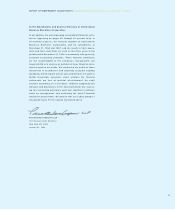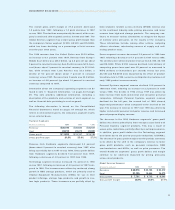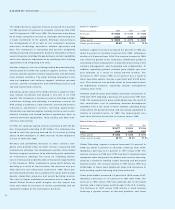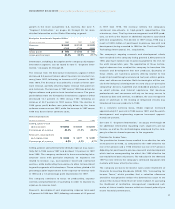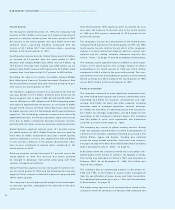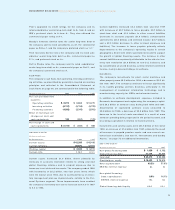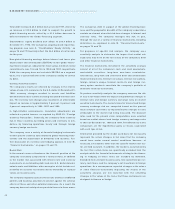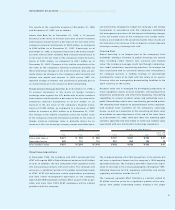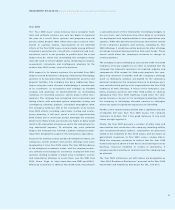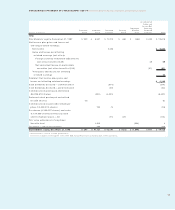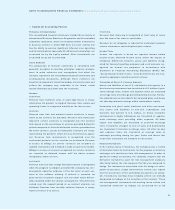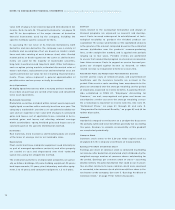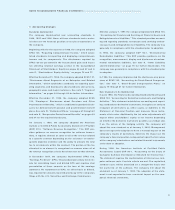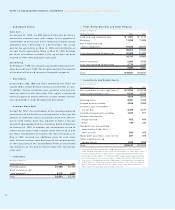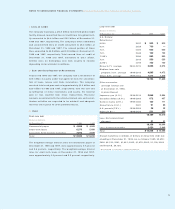IBM 1998 Annual Report Download - page 65
Download and view the complete annual report
Please find page 65 of the 1998 IBM annual report below. You can navigate through the pages in the report by either clicking on the pages listed below, or by using the keyword search tool below to find specific information within the annual report.
63
MANAGEMENT DISCUSSION International Business Machines Corporation and Subsidiary Companies
Year 2000
The “Year 2000 issue” arises because many computer hard-
ware and software systems use only two digits to represent
the year. As a result, these systems and programs may not
process dates beyond 1999, which may cause errors in infor-
mation or systems failures. Assessments of the potential
effects of the Year 2000 issues vary markedly among different
companies, governments, consultants, economists and com-
mentators, and it is not possible to predict what the actual
impact may be. Given this uncertainty, the company recog-
nizes the need to remain vigilant and is continuing its analysis,
assessment, conversion and contingency planning for the
various Year 2000 issues, across its business.
With respect to its internal systems, the potential Year 2000
impacts extend beyond the company’s information technology
systems to its manufacturing and development systems and
physical facilities. The company has been addressing these
issues using the same five-part methodology it recommends
to its customers: (1) assessment and strategy; (2) detailed
analysis and planning; (3) implementation; (4) maintaining
readiness of converted systems; and (5) project office man-
agement. The company has completed most conversion and
testing efforts, with extended system integration testing and
contingency planning projects scheduled throughout 1999.
The company estimates that at the conclusion of its various
Year 2000 efforts, including conversion, testing and contin-
gency planning, it will have spent a total of approximately
$575 million over a multi-year period. Although the company
believes its efforts will be successful, any failure or delay could
result in the disruption of business and in the company incur-
ring substantial expense. To minimize any such potential
impact, the company has initiated a global contingency plan-
ning effort designed to support critical business operations.
As part of its ordinary course product development efforts, the
company’s current product and service offerings have been
designed by it to be Year 2000 ready. The Year 2000 readiness
of the company’s customers varies, and the company contin-
ues actively to encourage its customers to prepare their own
systems, making available a broad array of product, service
and educational offerings to assist them (see the IBM Year
2000 Home Page at http://www.ibm.com/IBM /year2000/).
Efforts by customers to address Year 2000 issues may absorb
a substantial part of their information technology budgets in
the near term, and customers may either delay or accelerate
the deployment and implementation of new applications and
systems. While this behavior may increase demand for certain
of the company’s products and services, including its Year
2000 offerings, it could also soften demand for other offerings
or change customer buying practices from past trends. These
events could affect the company’s revenues or change its
revenue patterns.
The company is also continuing its assessment of the Year 2000
readiness of its key suppliers in an effort to establish that the
company has adequate resources for required supplies and
components. With respect to third-party products the com-
pany may remarket or provide with the company’s offerings
(such as third-party software pre-loaded on the company’s
personal computers), the company relies on its business part-
ners and other third parties to be responsible for the Year 2000
readiness of their offerings. A failure of the company’s sup-
pliers, business partners and other third parties to address
adequately their Year 2000 readiness could affect the com-
pany’s business. As part of its contingency planning efforts,
the company is identifying alternate sources or strategies
where necessary if significant exposures are identified.
Further, some commentators believe that a significant amount
of litigation will arise from Year 2000 issues. The company
continues to believe that it has good defenses to any such
claims brought against it.
Finally, the Year 2000 presents a number of other risks and
uncertainties that could affect the company, including utilities
and telecommunications failures, competition for personnel
skilled in the resolution of Year 2000 issues, and the nature of
government responses to Year 2000 issues, among others.
While the company continues to believe that the Year 2000
matters discussed above will not have a material impact on its
business, financial condition or results of operations, it
remains uncertain whether or to what extent the company may
be affected.
The Year 2000 statements set forth above are designated as
“Year 2000 Readiness Disclosures” pursuant to the Year 2000
Information and Readiness Disclosure Act (P.L. 105-271).


